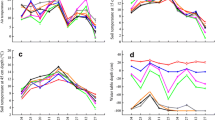Abstract
The fluxes of CO2 and CH4 emission of the two types of primary swamp were measured in Sanjiang Plain using the opaque chamber and gas chromatogram technique. The mean value of ecosystem respiration flux in continuously inundated swamp ecosystem is 548.04 mg · m−2 · h−1, lower than that of the seasonal inundated swamp (713.08 mg · m−2 · h−1). The peaks concentrated on July and August which are the growing period of the vegetation. CH4 emission was different from the respiration flux of ecosystem. The CH4 flux of continuously inundated swamp was 12.80 mg · m−2 · h−1, larger than that of the seasonal inundated swamp (8.56 mg · m−2 · h−1), and they were varied at different periods, the continuously inundated swamp emitted CH4 mainly from July to September, whereas from last August to middle September in the seasonal inundated swamp. The ecosystem respiration flux of the swamp has the significantly positive correlation with the soil temperature (0–10 cm depth) and the water temperature, but CH4 emission was associated with the soil temperature in a certain degree. The CH4 emission from swamp depends on the integral function of water table and soil temperature.
Similar content being viewed by others
References
Gorham, E., Northern peatlands: Role in the carbon cycle and probable responses to climatic warming, Ecol. Appl., 1991, 52: 182–195.
Oechel, W. C., Vourlitis, G. L., Hastings, S. J. et al., Change in arctic CO2 flux over two decades: Effects of climate change at Barrow, Alaska, Ecol. Appl., 1995, 5: 846–855.
Alm, J., Schulman, L., Walden, J., Nykanen, H., et al., Carbon balance of a boreal bog during a year with an exceptionally dry summer, Ecology, 1999, 80(1): 161–174.
Baron, J. S., Hartman, M. D., Band, L. E. et al., Sensitivity of a high-elevation Rocky Mountain watershed to altered climate and CO2, Water Resour. Res., 2000, 36(1): 89–99.
Barklett, K. B., Harriss, R. C., Review and assessment of methane flux from wetlands, Chemosphere, 1993, 26(4): 261–320.
Cicerone, R. J., Oremland, R. S., Biogeochemical aspects of atmospheric methane, Global Biogeochem. Cycles, 1988, 2(4): 299–327.
Houghton, J. T., IPCC (1995) Climate change 1994: Radiative Forcing of Climate Change and an Evaluation of the IPCC IS92 Emission Scenarios, Cambridge UK: Cambridge University Press, 1995, 337.
Mosier, A. R., Morgan, J. A., King, J. Y. et al., Soil-atmosphere exchange of CH4, CO2, NOx, and N2O in the Colorado shortgrass steppe under elevated CO2, Plant and Soil, 2002, 240: 201–211.
Hungate, B. A., Holland, E. A., Jackson, R. B. et al., The fate of carbon in grasslands under carbon dioxide enrichment, Nature, 1997, 388: 576–579.
Brix, H., Sorrell, B. K., Lorenzen, B., Are phragmites dominated wetlands a net source or net sink of greenhouse gases, Aquatic Botany, 2001, 69: 313–324.
Li, Y., Zhang, Y., Zhang, S., The landscape pattern and ecologic effect of the marsh changes in the Sanjiang Plain, Scientia Geographica Subuca (in Chinese), 2002, 22(6): 677–682.
Wickland, K. P., Carbon gas exchange at a southern Rocky Mountain wetland, 1996–1998, Global Biogeochem. Cycles, 2001, 15(2): 321–335.
Christensen, T. R., Michelsen, A., Jonasson, S. et al., Carbon dioxide and methane exchange of a subarctic heath in response to climate change related environmental manipulations, Oikos, 1997, 79: 34–44.
Dise, N. B., Methane emission from Minnesota peatlands: Spatial and seasonal variability, Global Biogeochem. Cycles, 1993, 7(1): 123–142.
Moore, T. R., Routlet, N. T., Methane flux: Water table relations in northern wetlands, Geophys. Res. Lett., 1993, 20(7): 587–590.
Moore, T. R., Roulet, N. T., Waddington, J. M., Uncertainty in predicting the effect of climatic change on the carbon cycling of Canadian peatlands, Clim. Change, 1998, 40: 229–245.
Frolking, S., Crill, P., Climate controls on temporal variability of methane flux from a poor fem in southeastern New Hampshire: Measurement and modeling, Global Biogeochem. Cycles, 1994, 8(4): 385–397.
Bellisario, L. M., Bubier, J. L., Moore, T. R. Controls on emissions from a northern peatland, Global Biogeochem. Cycles, 1999, 13(1): 81–91.
Author information
Authors and Affiliations
Corresponding author
About this article
Cite this article
Song, C., Yan, B., Wang, Y. et al. Fluxes of carbon dioxide and methane from swamp and impact factors in Sanjiang Plain, China. Chin. Sci. Bull. 48, 2749–2753 (2003). https://doi.org/10.1007/BF02901769
Received:
Accepted:
Issue Date:
DOI: https://doi.org/10.1007/BF02901769




